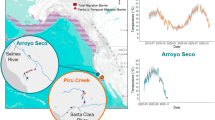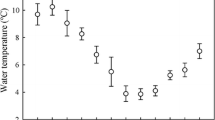Abstract
The threatened status of redside dace, Clinostomus elongatus, in Michigan inhibits study and management of remnant populations of the species. We present a phenotypic approach to evaluate the use of redside dace from New York as behavioral and physiological models for Michigan populations. We evaluated behavioral similarity by comparing patterns of microhabitat use and physiological similarity by comparing resting routine metabolic rates measured in the field. Variation between sites in available microhabitat made direct comparisons difficult; however, redside dace in Michigan and New York showed a common preference for mid-water positions in the deepest parts of pools under overhanging structure. Field measurements at 10°C showed that Michigan fish had higher metabolic rates than rates predicted for New York fish at the same temperature, though biological significance of this difference is questionable. In laboratory experiments, we measured metabolic rate and upper thermal tolerance in relation to acclimation temperatures of 6–20°C using redside dace collected from four streams in New York. Redside dace showed a significant increase in metabolic rate as acclimation temperature increased (Q10=2.3). Critical thermal maxima (CTM) of New York redside dace also increased with acclimation temperature. Obstacles related to the transferability of habitat use data and variation in physiology due to uncontrolled and unmeasured environmental factors in the field lead us to urge caution when extrapolating behavioral and physiological characteristics between widely-separated populations of a species. Despite these obstacles, we described useful patterns of microhabitat use and provided estimates of physiological tolerances that will assist resource managers in the recovery of Michigan redside dace.
Similar content being viewed by others
References cited
Altmann, J. 1974. Observational study of behavior: sampling methods. Behaviour 49: 226-267.
Bailey, R.M. & G.R. Smith. 1981. Origin and geography of the fish fauna of the Laurentian Great Lakes basin. Can. J. Fish. Aquat. Sci. 38: 1539-1561.
Baltz, D.M., P.B. Moyle & N.J. Knight. 1982. Competitive interactions between benthic stream fishes, riffle sculpin, Cottus gulosus, and speckled dace, Rhinichthys osculus. Can. J. Fish. Aquat. Sci. 39: 1502-1511.
Baltz, D.M. & P.B. Moyle. 1984. Segregation by species and size class of rainbow trout (Salmo gairdneri) and the Sacramento sucker (Catastomus occidentalis) in three California streams. Env. Biol. Fish. 10: 101-110.
Barrett, P.J. & O.E. Maughan. 1994. Habitat preferences of introduced smallmouth bass in a central Arizona stream. North Amer. J. Fish. Manage. 14: 112-118.
Becker, C.D. & R.G. Genoway. 1979. Evaluation of the critical thermal maximum for determining thermal tolerance of freshwater fish. Env. Biol. Fish. 4: 245-256.
Becker, G. 1983. Fishes of Wisconsin. University of Wisconsin Press, Madison. 1052 pp.
Binns, N.A. & R. Remmick. 1994. Response of cutthroat trout and their habitat to drainage-wide habitat management at Huff Creek, Wyoming. North Amer. J. Fish. Manage. 14: 669-680.
Bonin, J.D. 1981. Measuring thermal limits of fish. Trans. Amer. Fish. Soc. 110: 662.
Bozek, M.A. & F.J. Rahel. 1992. Generality of microhabitat suitability models for young Colorado River cutthroat trout (Oncorhynchus clarki pleuriticus) across sites and among years in Wyoming streams. Can. J. Fish. Aquat. Sci. 49: 552-564.
Brett, J.R. & T.D.D. Groves. 1979. Physiological energetics. pp. 279-352. In: W.S. Hoar & D.J. Randall (ed.) Fish Physiology, Vol. 6, Academic Press, New York.
Bryan, J.D., L.G. Hill & W.H. Neill. 1984. Interdependence of acute temperature preference in the plains minnow. Trans. Amer. Fish. Soc. 113: 557-562.
Castleberry, D.T. & J.J. Cech, Jr. 1986. Physiological responses of a native and an introduced desert fish to environmental stressors. Ecology 67: 912-918.
Cech, J.J. Jr., M.J. Massingill, B. Vondracek & A.L. Linden. 1985. Respiratory metabolism of mosquitofish, Gambusia affinis: effects of temperature, dissolved oxygen, and sex difference. Env. Biol. Fish. 13: 297-307.
Cech, J.J. Jr., S.J. Mitchell, D.T. Castelberry & M. McEnroe. 1990. Distribution of California stream fishes: influence of environmental temperature and hypoxia. Env. Biol. Fish. 29: 95-105.
Cherry, D.S., K.L. Dickson & J. Cairns, Jr. 1977. Preferred, avoided, and lethal temperatures of fish during rising temperature conditions. J. Fish. Res. Board Can. 34: 239-246.
Clausen, R.G. 1936. Oxygen consumption in fresh water fishes. Ecology 17: 216-226.
Daniels, R.A. & S.J. Wisniewski. 1994. Feeding ecology of redside dace, Clinostomus elongatus. Ecol. Fresh. Fish 3: 176-183.
Ege, R. & A. Krogh. 1914. On the relation between temperature and the respiratory exchange in fishes. Intern. Rev. ges. Hydrobiol. Hydrog. 7: 48-55.
Endler, J.A. 1986. Natural selection in the wild. Princeton University, Princeton. 336 pp.
Facey, D.E. 1987. Metabolic constraints and microhabitat selection in four stream fishes. Ph.D. Dissertation, University of Georgia, Athens. 91 pp.
Fausch, K.D., C. Gowan, A.D. Richmond & S.C. Riley. 1995. The role of dispersal in trout population response to habitat formed by large woody debris in Colorado mountain streams. Bulletin Français de la Pêche de la Pisiculture 337/338/339: 179-190.
Foster, S.A., J.A. Baker & M.A. Bell. 1992. Phenotypic integration of life history and morphology: an example from three-spined stickleback, Gasterosteus aculeatus L. J. Fish Biol. 41(Supplement B): 21-35.
Fry, F.E.J. 1971. The effect of environmental factors on the physiology of fish. pp. 1-98. In: W.S. Hoar & D.J. Randall (ed.) Fish Physiology, Vol. 6, Academic Press, New York.
Fry, F.E.J. & J.S. Hart. 1948. The relation of temperature to oxygen consumption in the goldfish. Biol. Bull. 94: 66-77.
Gatz, A. Jr. 1979. Ecological morphology of freshwater stream fishes. Tulane Stud. Zool. Bot. 21: 91-124.
Gilbert, C. 1980. Redside dace, Clinostomus elongatus. p. 148. In: D. Lee, C. Gilbert, C. Hocutt, R. Jenkins, D. McAllister & J. Stauffer, Jr. (ed.) Atlas of North American Freshwater Fishes, North Carolina State Museum of Natural History, Raleigh.
Groshens, T.P. & D.J. Orth. 1994. Transferability of habitat suitability criteria for smallmouth bass, Micropterus dolomieu. Rivers 4: 194-212.
Hill, J. & G.D. Grossman. 1993. An energetic model of microhabitat use for rainbow trout and rosyside dace. Ecology 74: 685-698.
Hurlbert, S.H. 1984. Pseudoreplication and the design of ecological field experiments. Ecological Monogr. 54: 187-211.
Jobling, M. 1981. Temperature tolerance and the final preferendum-rapid methods for the assessment of optimum growth temperatures. J. Fish Biol. 19: 439-455.
Karr, J.R., L.A. Toth & D.R. Dudley. 1985. Fish communities of midwestern rivers: a history of degradation. Bioscience 35: 90-95.
Konstantinov, A.S., V.V. Zdanovich & D.G. Tikhomirov. 1990. The effect of temperature fluctuations on metabolic rate and energetics of juvenile fish. J. Ichthyol. 30: 38-47.
Koster, W. 1939. Some phases of the life history and relationships of the cyprinid, Clinostomus elongatus (Kirtland). Copeia 1939: 201-208.
Kowalski, K.T., J.P. Schubauer, C.L. Scott & J.R. Spotila. 1978. Intraspecific and seasonal differences in the temperature tolerance of stream fish. J. Therm. Biol. 3: 105-108.
Matthews, W.J. 1986. Geographic variation in thermal tolerance of a widespread minnow Notropis lutrensis of the North American mid-west. J. Fish Biol. 28: 407-417.
McClanahan, L.L., C.R. Feldmeth, J. Jones & D.L. Soltz. 1986. Energetics, salinity and temperature tolerance in the mohave tui chub, Gila bicolor mohavensis. Copeia 1986: 45-52.
McKee, P. & B. Parker. 1982. The distribution, biology and status of the fishes Campostoma anomalum, Clinostomus elongatus, Notropis photogenis, and Fundulus notatus in Canada. Can. J. Zool. 60: 1347-1358.
Meade, L., D. McNeely, L. Kornman & A. Surmont. 1986. The redside dace, Clinostomus elongatus (Kirtland) in Kentucky, with comments about its habitat requirements. Trans. Kent. Acad. Sci. 47: 121-125.
Meffe, G.K. & C.R. Carroll. 1994. Principles of conservation biology. Sinauer, Sunderland. 600 pp.
Novinger, D.C. 1995. Behavioral, physiological and morphological similarity among populations of redside dace, a threatened species in Michigan. Masters Thesis, Michigan State University, East Lansing. 108 pp.
Paladino, F.V., J.R. Spotila, J.P. Schubauer & K.T. Kowalski. 1980. The critical thermal maximum: a technique used to elucidate physiological stress and adaptation in fishes. Rev. Can. Biol. 39: 115-122.
Parker, B., P. McKee & R. Campbell. 1988. Status of the redside dace, Clinostomus elongatus, in Canada. Can. Field-Nat. 102: 163-169.
Potvin, C. & D.A. Roff. 1993. Distribution-free and robust statistical methods: viable alternatives to parametric statistics? Ecology 74: 1617-1628.
Rajagopal, P.K. & R.H. Kramer. 1974. Respiratory metabolism of Utah chub, Gila atraria (Girard) and speckled dace, Rhinichthys osculus (Girard). J. Fish Biol. 6: 215-222.
Schwartz, F. & J. Norvell. 1958. Food, growth and sexual dimorphism of the redside dace Clinostomus elongatus (Kirtland) in Linesville Creek, Crawford County, Pennsylvania. The Ohio J. Sci. 58: 311-316.
Scott, N.L. 1987. Seasonal variation of critical thermal maximum in the redbelly dace, Phoxinus erythtogaster (Cyprinidae). Southwest. Nat. 32: 435-438.
Shields, B.A. & J.C. Underhill. 1993. Phenotypic plasticity of a transplanted population of dwarf cisco, Coregonus artedii. Env. Biol. Fish. 37: 9-23.
Smith, C. 1987. The inland fishes of New York State. Cornell University Press, Ithaca. 522 pp.
Smith, G.R., J. Taylor & T. Grimshaw. 1981. Ecological survey of fishes in the Raisin River drainage, Michigan. Mich. Acad. Sci. Papers 13: 275-305.
Strauss, R.E. 1979. Reliability estimates for Ivlev's electivity index, the forage ratio, and a proposed linear index of food selection. Trans. Amer. Fish. Soc. 108: 344-352.
Trautman, M. 1981. The fishes of Ohio. Ohio State University Press, Columbus. 782 pp.
White, M.M. 1988. Genetic variation and population structuring in the rosyside dace, Clinostomus funduloides, in Ohio. Ohio J. Sci. 88: 114-116.
Wilzbach, M.A. 1985. Relative roles of food abundance and cover in determining the habitat distribution of stream-dwelling cutthroat trout (Salmo clarki). Can. J. Fish. Aquat. Sci. 42: 1668-1672.
Winberg, G.G. 1956. Rate of metabolism and food requirements of fishes. J. Fish. Res. Board Can.Trans. Ser. 194, 1960, Ottawa. 251 pp.
Zar, J.H. 1984. Biostatistical analysis. Prentice Hall, Englewood Cliffs. 718 pp.
Author information
Authors and Affiliations
Rights and permissions
About this article
Cite this article
Novinger, D.C., Coon, T.G. Behavior and Physiology of the Redside Dace, Clinostomus elongatus, a Threatened Species in Michigan. Environmental Biology of Fishes 57, 315–326 (2000). https://doi.org/10.1023/A:1007526414384
Issue Date:
DOI: https://doi.org/10.1023/A:1007526414384




